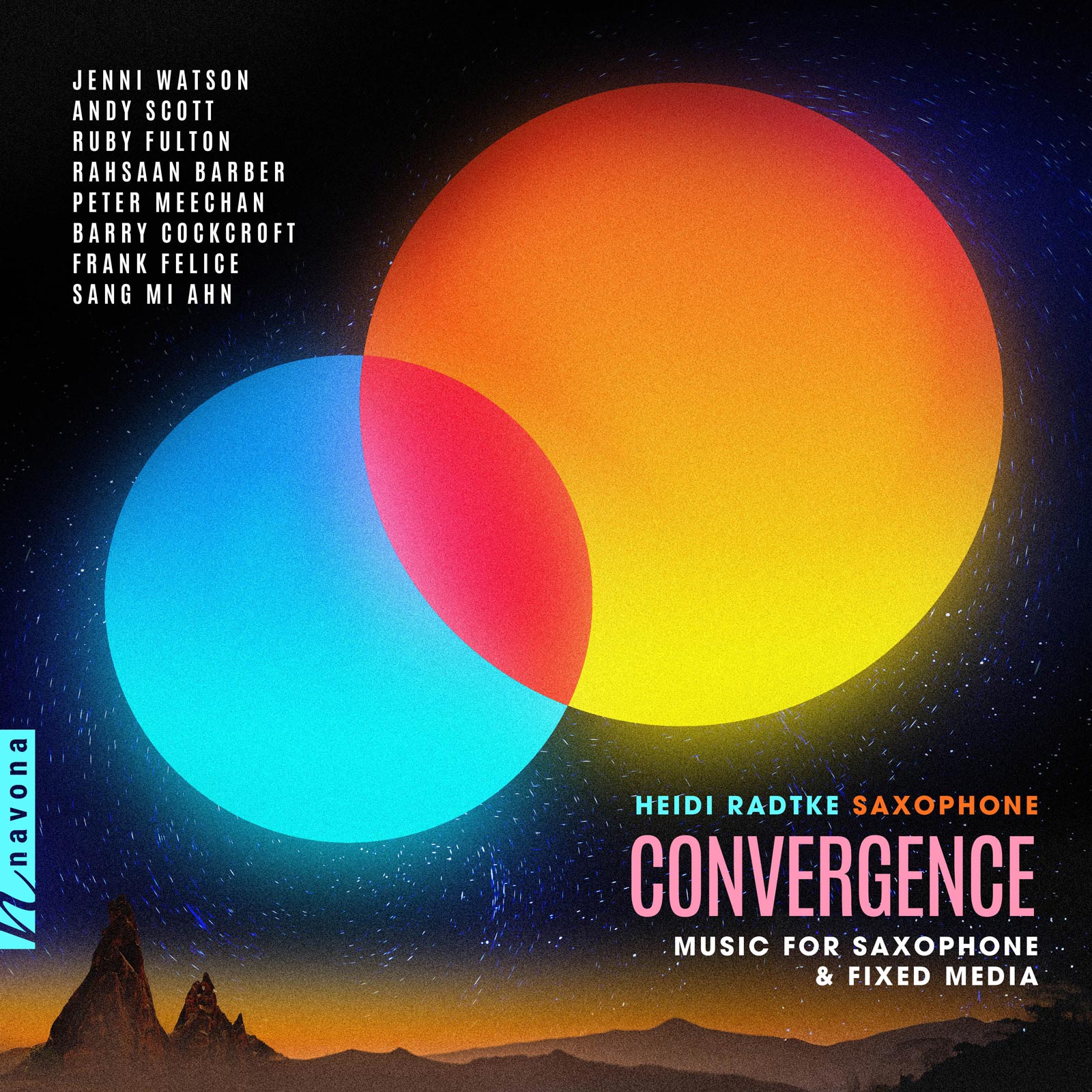Convergence
Jenni Watson composer
Andy Scott composer
Ruby Fulton composer
Rahsaan Barber composer
Peter Meechan composer
Barry Cockcroft composer
Frank Felice composer
Sang Mi Ahn composer
Heidi Radtke saxophone
What is music but a convergence of story, people, and place? It’s a question that Heidi Radtke’s debut album CONVERGENCE for soprano, alto, and tenor sax asks earnestly, an elegant meshing of the heartbeats behind the sounds of eight living composers, strung together by the laughter and conversation woven into each exploration, and the saxophone’s ability to tell its tale. The full breadth of Radtke’s capability is on display as she navigates the variety of narratives, messages, and sonic uniquities in the landscape of CONVERGENCE, sometimes bolstered forward with a bubbly charm — in the “chicken clucks” of Barry Cockcroft’s Ku Ku — and sometimes with a powerful, reminding grace, — Rahsaan Barber’s Breonna Taylor (How Many More?) – but always with a special musicality.
CONVERGENCE explores the intersection of instruments, musical tradition, and the saxophone’s ability to explore these soundscapes, especially in the format of saxophone with fixed media. From a reimagination of Debussy to field recordings of natural spaces and sounds taken completely from a cell phone, the fixed media selections boast a wide range of musical styles, but all are connected through storytelling.
Ending with the title track, Convergence, Radtke invites the listener to take part in the conversation — the best stories are the ones told together.
Listen
Stream/Buy
Choose your platform
Track Listing & Credits
| # | Title | Composer | Performer | |
|---|---|---|---|---|
| 01 | Arabesque (2018) | Jenni Watson | Heidi Radtke, alto saxophone | 5:07 |
| 02 | Westland (2018) | Andy Scott | Heidi Radtke, tenor saxophone | 5:52 |
| 03 | Wind Telephone (2018) | Ruby Fulton | Heidi Radtke, alto saxophone | 11:35 |
| 04 | Breonna Taylor (How Many More?) (2020) | Rahsaan Barber, arr. Heidi Radtke, Rahsaan Barber (2023) | Heidi Radtke, alto saxophone | 3:51 |
| 05 | 3 Pieces for Solo Saxophone (2004): 1am | Peter Meechan | Heidi Radtke, tenor saxophone | 2:44 |
| 06 | 3 Pieces for Solo Saxophone (2004): èlègie | Peter Meechan | Heidi Radtke, tenor saxophone | 3:25 |
| 07 | 3 Pieces for Solo Saxophone (2004): dawn song | Peter Meechan | Heidi Radtke, tenor saxophone | 3:47 |
| 08 | Ku Ku (1997) | Barry Cockcroft | Heidi Radtke, soprano saxophone | 6:48 |
| 09 | Ten Sacks o’ Sneaks and Snacks (2022) | Frank Felice | Heidi Radtke, tenor saxophone | 6:15 |
| 10 | Convergence (2011) | Sang Mi Ahn | Heidi Radtke, alto saxophone | 7:56 |
This recording was made possible through the University of North Carolina at Chapel Hill Department of Music Faculty Advancement and Research Program. A special thanks to Jay Harper for his support and brilliance.
Recorded May 30, 31, and June 1, 2023 at Moeser Auditorium, University of North Carolina at Chapel Hill in Chapel Hill NC
Recording Producer, Engineer, Editing and Mastering Jay Harper
Executive Producer Bob Lord
VP of A&R Brandon MacNeil
A&R Chris Robinson
VP of Production Jan Košulič
Audio Director Lucas Paquette
VP, Design & Marketing Brett Picknell
Art Director Ryan Harrison
Design Edward A. Fleming, Morgan Hauber
Publicity Chelsea Kornago
Digital Marketing Manager Brett Iannucci
Artist Information

Heidi Radtke
Driven to create a musical bond with her listeners, saxophonist Heidi Radtke is attracted to the many musical traditions that claim the saxophone as their own. With influences ranging from contemporary classical to jazz and popular genres, Radtke gravitates towards music that dances, sings, and tells a story. As a performing artist, Radtke seeks to entertain, provide emotional connection and release, stir creativity, pique curiosity, generate compassion, and above all, inspire the artistic voice in others.

Frank Felice
Frank Felice (b. 1961) is an eclectic composer who writes with a postmodern mischievousness: each piece speaks in its own language, and his works can be by turns comedic/ironic, simple/complex, subtle/startling, or humble/reverent. Recent projects of Felice’s have taken a turn toward the sweeter side, exploring a consonant adiatonicism.

